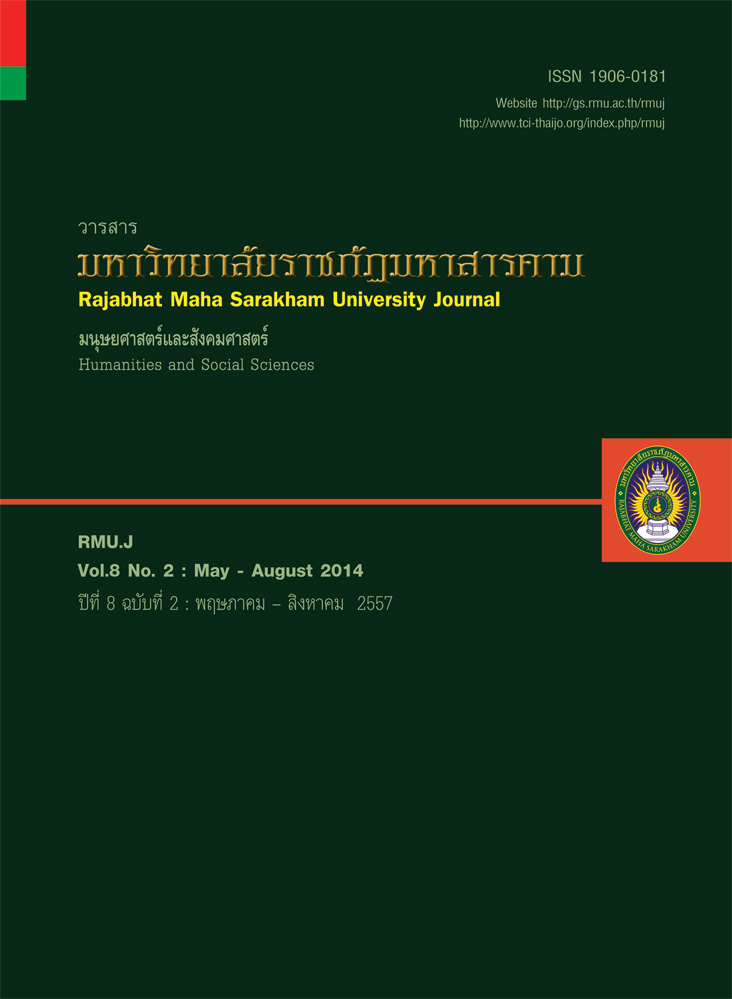การศึกษาความเข้าใจทางคณิตศาสตร์ ตามกรอบทฤษฏี Action-Process-Structure (APS) เรื่อง ลิมิตและความต่อเนื่องของฟังก์ชัน ของนักเรียนชั้นมัธยมศึกษาปีที่ 6 A Study on Mathematical Understandings of 12th Grade Students Based on the Action-Process-Structure Framew
Main Article Content
บทคัดย่อ
การวิจัยครั้งนี้มีวัตถุประสงค์เพื่อทำการศึกษาความเข้าใจทางคณิตศาสตร์ ตามกรอบทฤษฏี Action-process-structure (APS)
เรื่อง ลิมิตและความต่อเนื่องของฟังก์ชัน ของนักเรียนชั้นมัธยมศึกษาปีที่ 6 กลุ่มเป้าหมายที่ใช้ในการวิจัยครั้งนี้ ได้แก่ นักเรียนชั้น
มัธยมศึกษาปีที่ 6/1 โรงเรียนนาดูนประชาสรรพ์ จังหวัดมหาสารคาม ที่เรียนในภาคเรียนที่ 2 ปีการศึกษา 2554 จำนวนนักเรียน 45
คน ได้มาโดยการเลือกแบบเจาะจง (Purposive sampling) และเลือกนักเรียนจำนวน 6 คน เป็นกรณีศึกษาเครื่องมือที่ใช้ในการวิจัย
ครั้งนี้ ได้แก่ แบบทดสอบวัดความเข้าใจทางคณิตศาสตร์ เรื่อง ลิมิตและความต่อเนื่องของฟังก์ชัน เป็นแบบอัตนัย จำนวน 5 ข้อ มีค่า
ความยาก ระหว่าง 0.41-0.62 ค่าอำนาจจำแนกรายข้อ ระหว่าง 0.40-0.87 ค่าความเชื่อมั่นทั้งฉบับ เท่ากับ 0.725 และแบบสัมภาษณ์
แบบไม่มีโครงสร้าง วิเคราะห์ข้อมูลด้วยวิธีพรรณนาวิเคราะห์ ผลการวิจัยพบว่า
นักเรียนมีความเข้าใจทางคณิตศาสตร์ ข้อที่ 1 มีความเข้าใจระดับการจัดกระทำร้อยละ 88 และระดับกระบวนการร้อยละ 85
ข้อที่ 2 มีความเข้าใจระดับการจัดกระทำร้อยละ 85 และระดับกระบวนการร้อยละ 67 ข้อที่ 3 มีความเข้าใจระดับการจัดกระทำร้อยละ
84 ระดับกระบวนการร้อยละ 66 และระดับโครงสร้างร้อยละ 23 ข้อที่ 4 มีความเข้าใจระดับการจัดกระทำร้อยละ 86 ระดับกระบวนการ
ร้อยละ 65 และระดับโครงสร้างร้อยละ 27 และข้อที่ 5 มีความเข้าใจระดับการจัดกระทำร้อยละ 80 ระดับกระบวนการร้อยละ 68 และ
ระดับโครงสร้างร้อยละ 20
กรณีศึกษานักเรียนมีความเข้าใจทางคณิตศาสตร์ ข้อที่ 1 นักเรียนกลุ่มเก่งและกลุ่มอ่อน มีความเข้าใจทางคณิตศาสตร์ระดับ
การจัดกระทำและระดับกระบวนการ ครบทุกคน ข้อที่ 2 นักเรียนกลุ่มเก่ง มีความเข้าใจระดับการจัดกระทำ จำนวน 3 คนและระดับ
กระบวนการ จำนวน 2 คน นักเรียนกลุ่มอ่อน มีความเข้าใจระดับการจัดกระทำ จำนวน 3 คนและระดับกระบวนการ จำนวน 1 คน
ข้อที่ 3 นักเรียนกลุ่มเก่ง มีความเข้าใจระดับการจัดกระทำ จำนวน 3 คน ระดับกระบวนการและระดับโครงสร้าง จำนวน 1 คน นักเรียน
กลุ่มอ่อน มีความเข้าใจระดับการจัดกระทำ จำนวน 3 คน ระดับกระบวนการและระดับโครงสร้างไม่มีนักเรียนคนใดทำได้ ข้อที่ 4
นักเรียนกลุ่มเก่ง มีความเข้าใจระดับการจัดกระทำ จำนวน 3 คน ระดับกระบวนการและระดับโครงสร้าง จำนวน 2 คน นักเรียนกลุ่ม
อ่อนไม่มีความเข้าใจได้ทั้ง 3 ระดับ และข้อที่ 5 นักเรียนกลุ่มเก่ง มีความเข้าใจระดับการจัดกระทำ จำนวน 3 คน ระดับกระบวนการ
และระดับโครงสร้าง จำนวน 1 คน นักเรียนกลุ่มอ่อนไม่มีความเข้าใจทั้ง 3 ระดับและจากสรุปสัมภาษณ์ นักเรียนกลุ่มเก่งมีความเข้าใจ
ในระดับการจัดกระทำครบทุกคน เพราะนักเรียนเข้าใจนิยาม กฎ ทฤษฎีเกี่ยวกับลิมิตจึงนำมาใช้ในการหาคำตอบได้ ความเข้าใจระดับ กระบวนการครบทุกคนเพราะนักเรียนเข้าใจนิยาม ทฤษฏีวิธีการหาคำตอบลิมิตของฟังก์ชันบนช่วง และความเข้าใจระดับโครงสร้างมี
ความเข้าใจบางคน แต่บางคนก็หาคำตอบความต่อเนื่องของฟังก์ชันไม่ได้ เพราะไม่เข้าใจนิยาม ทฤษฏีและลำดับขั้นตอนวิธีการหาคำ
ตอบว่าแต่ละขั้นตอนมีวิธีการหาคำตอบอย่างไรจึงทำให้หาคำตอบความต่อเนื่องของฟังก์ชันไม่ได้ นักเรียนกลุ่มอ่อนมีความเข้าใจใน
ระดับการจัดกระทำครบทุกคน เพราะนักเรียนเข้าใจนิยาม กฎ ทฤษฎีเกี่ยวกับลิมิตจึงนำมาใช้ในการหาคำตอบได้ไม่มีความเข้าใจระดับ
กระบวนการและระดับโครงสร้างเพราะนักเรียนไม่เข้าใจนิยาม กฎ ทฤษฏี วิธีการหาคำตอบและลำดับขั้นตอนวิธีการหาคำตอบว่าแต่ละ
ขั้นตอนมีวิธีการหาคำตอบอย่างไรจึงทำให้หาคำตอบความต่อเนื่องของฟังก์ชันไม่ได้
The purpose of this research was to assess mathematical understandings of 12th grade students on
the topic of “Limits and Continuity of Functions by using Action-Process-Structure Theory. The target population
of the research, selected by the purposive random sampling was six students 12th grade students of
Nadoonprachasan School, Mahasarakham. The instruments used in this research were: 1) 5 multiple-choice
mathematical problems with 0.41 to 0.62 difficulty indices, .40-.87 discrimination indices and .725 validity
index, and 2) an interview form. The descriptive analysis was used for analyzing data.
The findings indicated that the levels of the understandings regarding the action and process of the
first question of both high-achieving students and low-achieving students were 88% and 85% respectively.
The levels of the understandings regarding the action and process of the second question of both
high-achieving students and low-achieving students were 85% and 67% respectively. The levels of the
understandings regarding the action, process and structure of the third question of both high-achieving
students and low-achieving students were 84%, 66% and 23% respectively. The levels of the understandings
regarding the action, process and structure of the fourth question of both high-achieving students and
low-achieving students were 86%, 65% and 27% respectively. The levels of the understandings regarding
the action, process and structure of the fifth question of both high-achieving students and low-achieving
students were 80%, 68% and 20% respectively.
In case of the mathematical understandings of the students, the findings showed that all high-achieving
students and low-achieving students understood the action and process of the first question. Three
high- achieving students understood the action of the second question and two high-achieving students
understood the process of the second question. Whereas, three low-achieving students understood the action
of the second question, and one low-achieving student understood the process. Three high-achieving students
understood the action of the third question, one high-achieving student understood the process and the
structure of the third question. In addition, only three low-achieving students understood the action of the
third question. Three high- achieving students understood the action of the fourth question, and two
high-achieving students understood the process and the structure of the fourth question. Whereas, all
low-achieving students did not understand all three levels of the mathematical understandings. Three
high-achieving students understood the action of the fourth question, and one high-achieving student understood the process and the structure of the fourth question. Whereas, all low-achieving students did not
understand all three levels of the mathematical understanding. Accordance with the interview, the study
showed that all high-achieving students of the target population understood the action of mathematical
problems because they understood the definition, rule and theory of “Limits”, and they also understood the
process of five questions because they understood the definition, and theory for finding an answer of “Functions
of Limits”. Some students did not understand the structure of mathematical problems because they could not
find an answer of the Continuity of Functions” , they did not understand definition, theory and process of
finding an answer. All low-achieving students of the target population understood the action of mathematical
problems because they understood the definition, rules, and theory of “Functions of Limits”, and they employed
the understandings for finding an answer. However, all low- achieving students of the target population did
not understand the process and structure of mathematical problems because they did not understand the
definition, rules, theory and method for finding an answer of “the Continuity of Functions” of each step.
Article Details
1. บทความที่ลงตีพิมพ์ทุกเรื่องได้รับการตรวจทางวิชาการโดยผู้ประเมินอิสระ ผู้ทรงคุณวุฒิ (Peer Review) สาขาที่เกี่ยวข้อง อย่างน้อย 3 ท่าน ในรูปแบบ Double blind review
2. ข้อคิดเห็นใด ๆ ของบทความที่ลงตีพิมพ์ในวารสารมหาวิทยาลัยราชภัฏมหาสารคาม นี้เป็นของผู้เขียน คณะผู้จัดทำวารสารไม่จำเป็นต้องเห็นด้วย
3. กองบรรณาธิการวารสารมหาวิทยาลัยราชภัฏมหาสารคาม ไม่สงวนสิทธิ์การคัดลอกแต่ให้อ้างอิงแสดงที่มา


